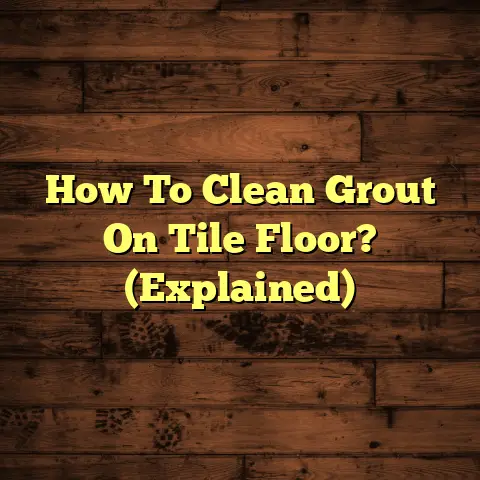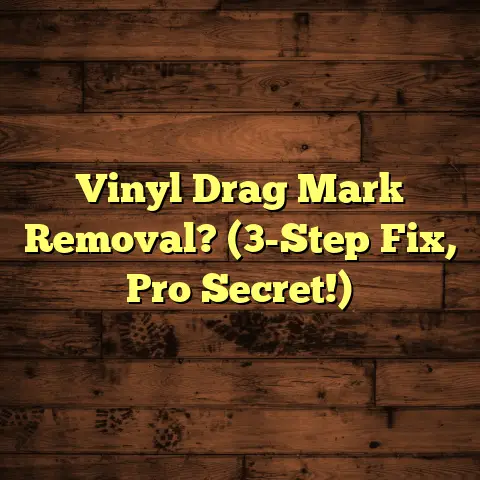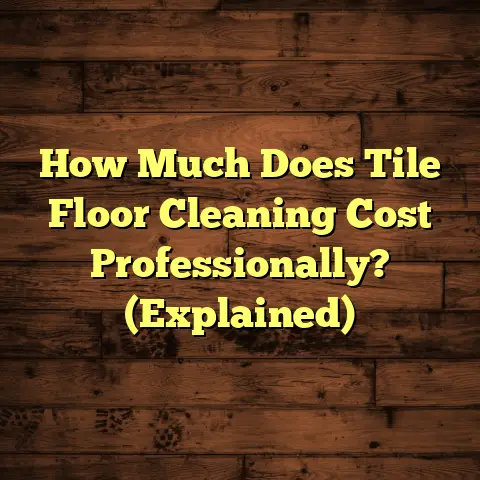Fill Concrete Cracks? (2 Products To AVOID!)
Imagine this: You’ve got a beautiful concrete patio, the heart of your outdoor living space. It’s seen countless BBQs, family gatherings, and quiet evenings under the stars.
Then, BAM! You spot it. A small crack, a tiny imperfection. At first, it seems insignificant, just a cosmetic blemish.
But what if that little crack is a warning sign? A sign of deeper structural issues lurking beneath? What if it leads to water seeping in, then mold, and eventually, a complete overhaul that costs you thousands?
You’re faced with a choice: A quick fix, or a long-term solution. Which products can you trust, and which should you run from?
Let’s dive in and find out!
1. Understanding Concrete Cracks
Alright, let’s get down to basics. What are concrete cracks, anyway? And why do they happen?
Concrete cracks are essentially fractures or separations in the concrete material. They can range from hairline fissures to wide, gaping chasms.
They’re often caused by a combination of factors:
-
Shrinkage: As concrete dries and cures, it shrinks. This can create stress that leads to cracking. Think of it like a rubber band that’s stretched too tight.
-
Load Stress: Excessive weight or pressure on the concrete can cause it to crack. Imagine a bridge that’s overloaded with traffic.
-
Settlement: If the ground beneath the concrete shifts or settles unevenly, it can cause the concrete to crack. This is common in areas with unstable soil.
Now, let’s talk about the different types of concrete cracks you might encounter:
-
Shrinkage Cracks: These are usually small, hairline cracks that appear shortly after the concrete is poured. They’re often random and don’t pose a significant structural threat.
-
Structural Cracks: These cracks are wider and deeper than shrinkage cracks. They’re usually caused by excessive load or settlement and can compromise the structural integrity of the concrete.
-
Settlement Cracks: These cracks are often diagonal and can be quite wide. They’re a clear sign that the ground beneath the concrete is shifting.
Ignoring small cracks might seem harmless now, but it can lead to big problems down the road. Water can seep into the cracks, causing corrosion of the reinforcing steel (rebar) within the concrete.
This can weaken the structure and eventually lead to failure. Plus, water infiltration can lead to mold and mildew growth, which can be a health hazard.
2. The Importance of Proper Repair
Okay, so we know cracks are bad news. But why is it so important to fix them properly?
Well, properly filling concrete cracks is crucial for maintaining the integrity of your concrete structures. Think of it like patching a hole in your roof. If you don’t do it right, you’re just asking for trouble.
Here are some key benefits of timely repairs:
-
Preventing Moisture Intrusion: This is the big one. Filling cracks prevents water from seeping into the concrete and causing further damage.
-
Avoiding Structural Damage: By addressing cracks early, you can prevent them from widening and compromising the structural integrity of the concrete.
-
Maintaining Aesthetic Appeal: Let’s face it, cracked concrete is an eyesore. Filling cracks can restore the beauty of your concrete surfaces.
-
Preventing Trip Hazards: Wide cracks can become tripping hazards, especially in high- traffic areas.
I’ve seen countless situations where a small, ignored crack turned into a major headache. Don’t let that happen to you!
3. Overview of Common Concrete Repair Products
So, what are your options when it comes to filling concrete cracks? There’s a whole range of products out there, each with its own strengths and weaknesses.
Here’s a quick rundown of some common types:
-
Epoxies: These are strong, two-part adhesives that are excellent for filling structural cracks. They provide a durable, waterproof seal.
-
Polyurethane Foams: These foams expand to fill the crack and create a flexible, water-resistant barrier. They’re often used for larger cracks and voids.
-
Cementitious Patching Compounds: These are mixtures of cement, sand, and other additives that are used to fill cracks and repair damaged concrete surfaces.
-
Acrylic Concrete Sealants: These are flexible, paintable sealants that are ideal for filling small, non-structural cracks.
Now, here’s the thing: not all products are created equal. Some are far better than others in terms of durability, adhesion, and resistance to the elements.
And that’s where things can get tricky. You need to choose the right product for the job, or you could end up wasting your time and money.
4. Product To Avoid #1: Low-Quality Sealants
Alright, let’s get to the nitty-gritty. The first product I want you to avoid like the plague is low-quality acrylic sealants.
I’m talking about those cheap, generic sealants you find at the dollar store or the bargain bin at your local hardware store.
These sealants might seem like a quick and easy fix, but trust me, they’re not worth the trouble. They’re often made with inferior ingredients that don’t hold up to the rigors of outdoor use.
Here’s why these sealants fail:
-
Poor Adhesion: They don’t bond well to the concrete, which means they’ll peel or crack over time.
-
Lack of Flexibility: Concrete expands and contracts with temperature changes. Low-quality sealants are often too rigid to accommodate this movement, which leads to cracking.
-
Susceptibility to UV Damage: The sun’s ultraviolet (UV) rays can break down these sealants, causing them to become brittle and crack.
-
Water Absorption: Some low-quality sealants are porous, meaning they absorb water. This can lead to freeze-thaw damage in colder climates.
I’ve seen countless cases where homeowners used these cheap sealants to fill concrete cracks, only to have them fail within a few months. The sealant cracks, peels, and crumbles, leaving the concrete even worse than before.
It’s like putting a band-aid on a broken leg. It might look okay for a little while, but it’s not going to solve the underlying problem.
Case Study:
I once worked on a project where a homeowner had used a low-quality acrylic sealant to fill cracks in his driveway. Within a year, the sealant had cracked and peeled, and the driveway looked terrible. We ended up having to remove all the old sealant and apply a high-quality epoxy to properly repair the cracks. It cost the homeowner more in the long run than if he had just used the right product in the first place.
Personal Experience:
I remember one time, early in my career, I tried to save a few bucks by using a cheap sealant on a small crack in my own patio. Big mistake! The sealant cracked within weeks, and I had to redo the entire job. That’s when I learned the importance of using quality materials.
5. Product To Avoid #2: Fast-Setting Concrete Patch Products
Okay, let’s move on to the second product you should be wary of: fast-setting concrete patch products.
These products are designed to quickly repair small holes and spalls in concrete surfaces. They’re often marketed as a convenient way to fix damaged concrete in a hurry.
And while they can be useful in certain situations, they’re not ideal for filling concrete cracks.
Here’s why:
-
Brittleness: Fast-setting concrete patch products tend to be more brittle than regular concrete. This means they’re more likely to crack under stress.
-
Inadequate Bonding: They may not bond well to the surrounding concrete, which can lead to delamination (separation) over time.
-
Different Expansion/Contraction Rates: These products may have different thermal expansion and contraction rates than the surrounding concrete. This can cause stress at the interface between the patch and the original concrete, leading to cracking.
-
Limited Flexibility: Concrete cracks often move slightly over time due to temperature changes and soil movement. Fast-setting patch products are typically too rigid to accommodate this movement, which can lead to cracking.
I’ve seen situations where homeowners used fast-setting patch products to fill concrete cracks, only to have the patch crack and fail within a few months. The patch often pops out of the crack, leaving an even bigger mess than before.
Testimonial:
“I tried using a fast-setting concrete patch to fix a crack in my sidewalk. It seemed like a great solution at first, but within a few weeks, the patch started to crack and crumble. Now, the sidewalk looks even worse than it did before.” – John S., Homeowner
Analogy:
Think of it like trying to repair a flexible rubber hose with a rigid piece of plastic. The plastic might hold for a little while, but eventually, it’s going to crack under the stress of the bending and flexing.
6. The Consequences of Choosing the Wrong Product
So, what happens if you choose the wrong product to fill your concrete cracks? Well, the consequences can be pretty significant.
Here’s a rundown of the potential problems:
-
Financial Implications: Using ineffective products can lead to increased repair frequency and, eventually, more costly repairs. You might think you’re saving money by using a cheaper product, but you could end up paying more in the long run.
-
Increased Repair Frequency: If the product fails, you’ll have to redo the repair. This means more time, effort, and money spent on the same problem.
-
Potential Safety Hazards: Cracks in concrete surfaces can create tripping hazards, especially for the elderly or those with mobility issues. If the repair fails, the hazard remains.
-
Aesthetic Degradation: Ineffective repairs can make your concrete surfaces look even worse than before. Cracks, peeling, and discoloration can detract from the overall appearance of your property.
-
Structural Damage: If water seeps into the cracks, it can cause corrosion of the reinforcing steel (rebar) within the concrete. This can weaken the structure and eventually lead to failure.
Investing in quality materials and proper techniques is essential for lasting repairs. Don’t cut corners when it comes to concrete repair. It’s better to do it right the first time than to have to redo it later.
7. Signs That Your Repair is Failing
How do you know if your concrete crack repair is failing? Here are some common signs to watch out for:
-
New Cracks Forming: If new cracks are forming near the repaired area, it’s a sign that the repair is not holding up.
-
Peeling or Flaking: If the repair material is peeling or flaking off the concrete, it’s a sign that it’s not bonding properly.
-
Discoloration: If the repaired area is discoloring, it could be a sign of moisture infiltration or material degradation.
-
Cracking of the Repair Material: If the repair material itself is cracking, it’s a sign that it’s not flexible enough to accommodate movement in the concrete.
-
Water Seepage: If you see water seeping through the repaired area, it’s a clear sign that the repair is not waterproof.
-
Hollow Sound: If you tap on the repaired area and it sounds hollow, it could be a sign that the repair material is delaminating from the concrete.
If you notice any of these signs, it’s important to address the problem as soon as possible. Ignoring these signs can lead to further damage and more costly repairs.
8. Conclusion
So, there you have it. We’ve covered a lot of ground when it comes to filling concrete cracks. We’ve talked about what cracks are, why they happen, and why it’s so important to repair them properly.
We’ve also identified two types of products that you should generally avoid: low-quality sealants and fast-setting concrete patch products.
Remember, while it might be tempting to opt for cheaper or quicker solutions, investing in quality repairs is essential for maintaining the structural integrity and aesthetic quality of your concrete surfaces.
Choose the right products, follow proper techniques, and you’ll be well on your way to keeping your concrete looking great for years to come.
Don’t let those little cracks turn into big problems!
Be smart, be proactive, and your concrete will thank you.





